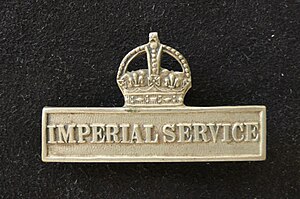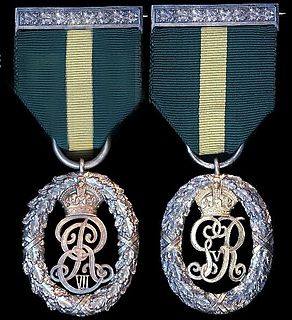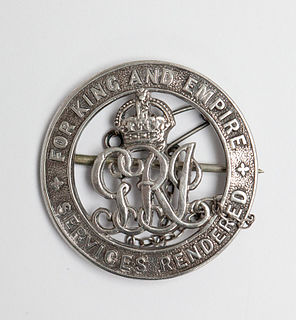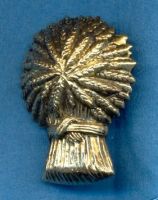| Territorial Force Imperial Service Badge | |
|---|---|
The Imperial Service Badge | |
| Awarded by The United Kingdom | |
| Type | Badge |
| Eligibility | Those officers, NCOs and men of the Territorial Force, who undertook liability in the event of national emergency, to serve in any place outside the United Kingdom, in accordance with the provisions of Section XIII (2) (a) of the Territorial and Reserve Forces Act, 1907. |
| Campaign(s) | Pre-WW1 and First World War. |
| Status | This award:
|
| Description | as follows:
|
| Statistics | |
| Established | 1910 |
The Territorial Force Imperial Service Badge was a short-lived decoration of the United Kingdom awarded to those members of the Territorial Force (TF) who were prepared to serve outside the United Kingdom in defence of the Empire, in the event of national emergency. The conditions of enlistment for the TF laid down at their creation in 1908 did not allow for soldiers to be sent for service overseas against their will, as the TF was intended for home defence. However, any man could volunteer for the Imperial Service Section and serve abroad in times of war, which entitled him to wear this badge. [1]

The United Kingdom, officially the United Kingdom of Great Britain and Northern Ireland but more commonly known as the UK or Britain, is a sovereign country lying off the north-western coast of the European mainland. The United Kingdom includes the island of Great Britain, the north-eastern part of the island of Ireland and many smaller islands. Northern Ireland is the only part of the United Kingdom that shares a land border with another sovereign state—the Republic of Ireland. Apart from this land border, the United Kingdom is surrounded by the Atlantic Ocean, with the North Sea to the east, the English Channel to the south and the Celtic Sea to the south-west, giving it the 12th-longest coastline in the world. The Irish Sea lies between Great Britain and Ireland. With an area of 242,500 square kilometres (93,600 sq mi), the United Kingdom is the 78th-largest sovereign state in the world. It is also the 22nd-most populous country, with an estimated 66.0 million inhabitants in 2017.
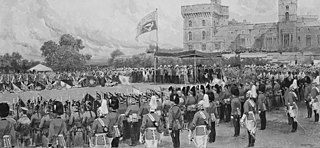
The Territorial Force was a part-time volunteer component of the British Army, created in 1908 to augment British land forces without resorting to conscription. The new organisation consolidated the 19th-century Volunteer Force and yeomanry into a unified auxiliary, commanded by the War Office and administered by local County Territorial Associations. The Territorial Force was designed to reinforce the regular army in expeditionary operations abroad, but because of political opposition it was assigned to home defence. Members were liable for service anywhere in the UK and could not be compelled to serve overseas. In the first two months of the First World War, territorials volunteered for foreign service in significant numbers, allowing territorial units to be deployed abroad. They saw their first action on the Western Front during the initial German offensive of 1914, and the force filled the gap between the near destruction of the regular army that year and the arrival of the New Army in 1915. Territorial units were deployed to Gallipoli in 1915 and, following the failure of that campaign, provided the bulk of the British contribution to allied forces in the Sinai and Palestine Campaign. By the war's end, the Territorial Force had fielded twenty-three infantry divisions and two mounted divisions on foreign soil. It was demobilised after the war and reconstituted in 1921 as the Territorial Army.

The British Empire comprised the dominions, colonies, protectorates, mandates and other territories ruled or administered by the United Kingdom and its predecessor states. It originated with the overseas possessions and trading posts established by England between the late 16th and early 18th centuries. At its height, it was the largest empire in history and, for over a century, was the foremost global power. By 1913, the British Empire held sway over 412 million people, 23% of the world population at the time, and by 1920, it covered 35,500,000 km2 (13,700,000 sq mi), 24% of the Earth's total land area. As a result, its political, legal, linguistic and cultural legacy is widespread. At the peak of its power, the phrase "the empire on which the sun never sets" was often used to describe the British Empire, because its expanse around the globe meant that the sun was always shining on at least one of its territories.
The badge was worn on the right breast of the uniform. It was not compulsory for the badge to be worn.
This badge became obsolete when the Territorial Force was elevated to become the Territorial Army. [2]
